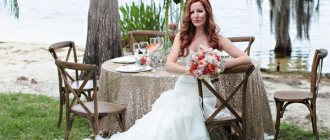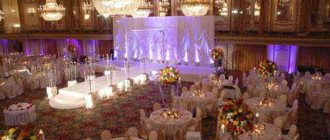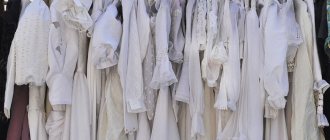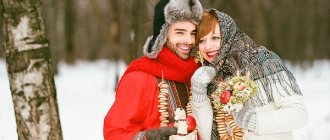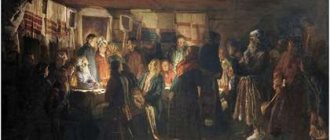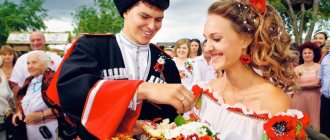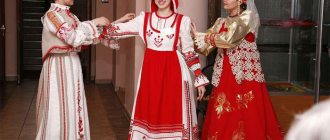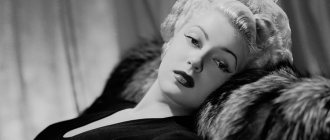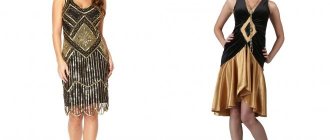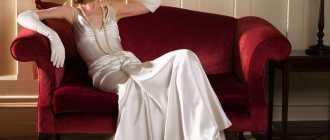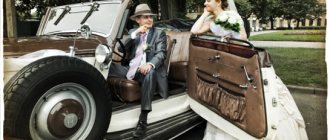Instead of studios
Is it possible to create in the studio everything that reflects the rustic style? Probably not, so they shoot more often in nature or look for interesting places. And here is a unique place where you can not only take pictures, but also take a walk, enjoy traditional dishes, and have a great time. Well, why not enjoy it?
We provide respected masters of photography with:
- Interiors of bath houses, decorated in Russian style. Each tower and hut has something special that can be emphasized;
- Hay room for romantic and cozy pictures;
- Landscapes and magical backgrounds, where everything is like in a fairy tale.
Difficulties
It was -17 outside. Tolerable, but after each shooting I ran into the hut to warm up. You can’t put on a “fur coat” - it’s not convenient to take off, so I filmed in a jacket with a scarf
The difficulty of shooting outdoors was that the lens fogged up every time. I had to wipe it with a cloth.
I think this is the calmest, most successful project. Calm in the sense that there is no need to fuss, run, etc. Successful - because we have revived the beauty of an era that has sunk into oblivion! For me, remembering and immersing myself in such an atmosphere is super cool!
But - like everywhere else, there is a “but” - these are things! Huge bags of clothes had to be transported in a large vehicle. ]
Ideas for photos
A folk-style photo shoot is a great field for imagination; the photographer can offer his ideas, or he can listen to yours. There can be many stories:
- Russian beauty. A princess or princess in all her glory against the backdrop of towers can show her strength or fragility, and the main thing will be her inner beauty, which will be reflected in the picture;
- Love Story. A wonderful occasion to capture a love story before marriage or write a fairytale chapter about a mature relationship;
- Wedding photo shoot. The entire celebration, captured on camera, photographs of guests and newlyweds, all this can be done in the Russian style. Traditional feasts, rituals, romantic kisses, vows of love and fidelity will remain with you for life;
- Family photos. The family in Rus' has always been special - the spouses tenderly trusted each other, cared for each other, there was always harmony between the feminine and masculine principles. And now these family foundations allow people to live in peace and harmony. Taking a photo means capturing a stage in a family’s history: with babies, with older children, or in anticipation of a miracle;
- Photo sessions in Russian costumes. It's always great to feel like a real hero or prince, or perhaps you want to be in the guise of a historical character.
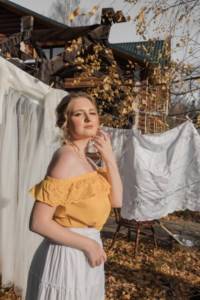
Wear in Russian: this mysterious style a la Russe
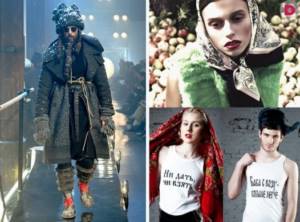
“Russian expansion” in world fashion began at the beginning of the 20th century. Its founder is considered to be the French clothing designer Paul Poiret. Immediately after Diaghilev’s first “Russian Season” in Paris, fascinated by the splendor of the performances, he created a collection that featured motifs of Russian folk clothing (1910-1914).
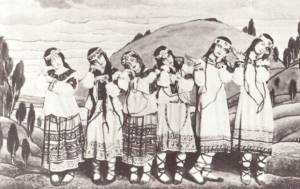
Scene from the play “The Rite of Spring”
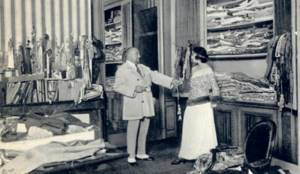
Paul Poiret in his studio
Bright colors, incredible styles, luxurious headdresses attracted the eye and could not leave any esthete indifferent.
Our chic noblewomen began to enter the most high-born and noble houses of Europe, and traditional Russian outfits became the object of desire of all European fashionistas of the early twentieth century. From 1910 to 1920, about 20 fashion houses opened in Paris alone, which cultivated the Russian style, admired it and tried to show love and respect through the collections they created.
After the revolution of 1917, with the influx of emigrants from Russia, a craze for the “a la Russ” style began in Europe. Teahouses and restaurants with gypsies and samovars open, scarves, kosovorotkas, coats “in the Russian style” with fur-trimmed cuffs and hem, and much more come into fashion. Russian collections appear in many fashion houses, including Chanel and Lanvin.
“I was simply fascinated by the Russians. Their eternal “everything that is mine is yours” is simply intoxicating,” admitted Coco Chanel.
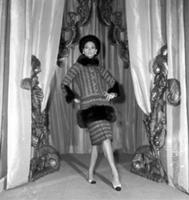
Moreover, the style of the 20s serves as an ideal basis for the elements of Russian folk costume (rhythmic patterns fit perfectly with a straight silhouette and clean lines).
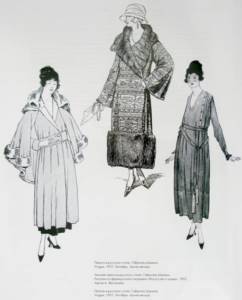
Models from the “Russian Collection” of Chanel
In 1976, Yves Saint Laurent presented to the world his collection “Opera-Ballets russes”
Yves Saint Laurent was one of the first designers to create collections dedicated to Russia. In 1957, after the death of Christian Dior, he headed his famous house and it was he who dared to bring the Dior collection to Soviet Moscow in 1959. Perhaps that was when the designer’s love affair with Russia began, which ended with the creation of the Russian collection in 1976.
“Russian Collection” of 1976 is a fantasy on the theme. It did not become a revelation - Saint Laurent himself considered it “not the best, but the most beautiful of those created” by him, but it was the first such literal appeal to the Russian theme since Paul Poiret.
After the show, many fashion designers turned their attention to the Russian style and began to use the elements they liked in their works.
And exactly 10 years later, Jean-Paul Gaultier creates a collection inspired by Soviet constructivism and clothing sketches by Varvara Stepanova and Lyubov Popova.
“Russian Collection” Gean-Paul Gaultier
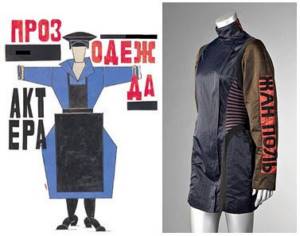
Since then, elements of Russian costume periodically appear in the collections of designers around the world.
In 1994, John Galliano created the collection “The Escape of the Young Princess Lucrezia from Bolshevik Russia.” The designer was inspired to create it by images of Russian women in 19th-century literature, in particular Sonya Marmeladova and Anna Karenina. The models were dressed in fur capes, fluffy dresses with lace and numerous draperies
What else inspired world designers?
Pretentiousness, handmade and a decisive no to minimalism! Thanks to Dolce&Gabbana and Valentino for promoting Russian motifs.
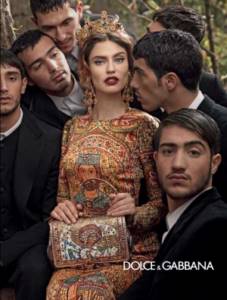
DOLCE&GABBANA AUTUMN-WINTER 2013-2014
John Galliano was once delighted by the Russian circus and ballet school, the Summer Palace and the Hermitage, the Tretyakov Gallery and Red Square, Moscow and St. Petersburg. We were delighted and inspired to create the a-la Rus collection. In 2009, the world saw the “Russian” collection of John Galliano. Among the many works devoted to the style of a Russian woman, the artist singled out Surikov’s famous painting “Boyarina Morozova” and dedicated one of his models to it.
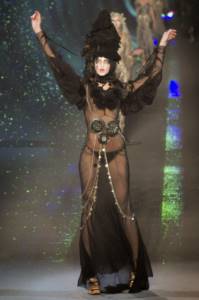
In 2002, American fashion designer Oscar de la Renta released the stunning “Russian Winter” collection, after which he announced to the world his retirement from the fashion world. But he soon changes his mind and returns to the fashion business.
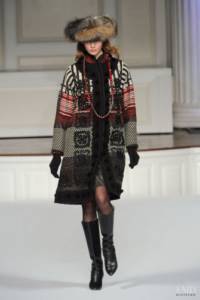
And already in 2009 he again released a collection dedicated to Russia - “Russian Fairy Tale”. This time, the famous designer’s collection was inspired by Russian folk crafts: Zhostovo trays, Khokhloma painting and patchwork.
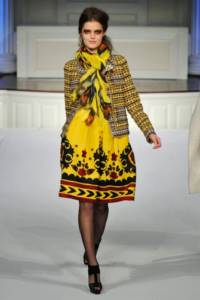
In the same 2009, the famous “Russian” photo shoot of Kenzo was released, who, like no one else, was imbued with Russian culture. Here are Russian scarves, felt boots, traditional patterns, coarse knitting and even a hut with the sweetest and dearest grandmother.
2009 became a “Russian” year for the Chanel fashion house. This year, Karl Lagerfeld released his famous "Paris-Moscow" collection, in which he introduced the world to his vision of the Soviet uniform, combined with kokoshniks, Faberge art and inverted domed heels.
So, what can be classified as typically Russian?
Russians love embroidery. Embroidery in Rus' was not only decorative. It was a talisman, and each of its details had its own purpose and symbolic meaning.

Russians love “expensive and rich”.
This feature of the Russian style is still legendary. A Russian woman, having seized upon something beautiful, often does not know how to stop and is ready to wear all the best at once. Yes, there is nothing surprising in this. That’s why she’s a “fair maiden”, to be beautiful from head to toe!

Folk crafts are in fashion.
Gzhel, Khokhloma, Zhostovo painting, Palekh. Each of them has its own characteristics - colors, characteristic brush strokes and subject matter of the images. All of them are unique, distinctive and belong to certain areas.

Russian lace.
In Rus', the first woven lace appeared in the 13th century. In Europe only in the 16th century.
Later, along with the fashion for European dress under Peter I, overseas lace began to come to Russia. But Russian needlewomen enriched foreign patterns with motifs of Russian folk embroidery to such an extent that woven lace entered the history of world culture under the name Russian.

Venus in furs.
Fur has always been valued in our country. In Rus' it was called “soft gold”: the fur of wild animals was the main, and sometimes the only currency for foreign trade. And both women and men wore furs. For foreigners, a fur coat is as much a calling card of Russia as a hat with earflaps.

Russians love roses.
Let us at least remember the worn-out but not forgotten Pavlopasad shawls.
And in general, as in any ethnic clothing, floral motifs were actively used in Rus'. And with the development of the weaving industry, they began to be used everywhere and cover entire fabrics.

A riot of colors, layers and ribbons.
Color, like any image or embroidery on ancient Russian clothing, had a symbolic meaning. Festive outfits were distinguished by a special abundance of color and detail. And the now fashionable layering was known to our distant ancestors. A woman's costume in Rus' consisted of several layers (shirt, underskirt - "poneva", sundress, outerwear), creating volume. There was no talk about darts or fit. At most, the sundress could be belted.
Ribbons on clothes and hats are a festive element, and only unmarried girls could wear such a headdress. Such elements are more typical for Ukrainian folk costumes.

Thus, it becomes obvious that the Russian heritage was then used mainly by European brands.
RUSSIAN STYLE IN RUSSIAN PERFORMANCE However, clearly represented in the collections of modern Russian designers who are familiar with the A La Russe theme firsthand. The apotheosis of the Russian style is the work of Vyacheslav Zaitsev. Luxurious colorful fabrics, an abundance of embroidery, ornaments, fur and large jewelry make his creations a real animated encyclopedia of Russian fashion. At one time, kitsch Khokhloma from the Russian designer Denis Simachev, whose creative activity covered not only clothes and shoes, but also cars, mobile phones (“Simaphones”) and furniture, was also very popular in the West .
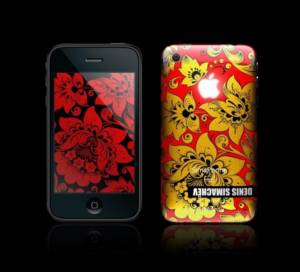
Igor Gulyaev approached the creation of his collection with a truly Russian scale, taking lush natural furs as a basis..
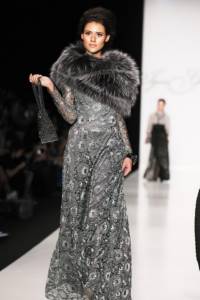
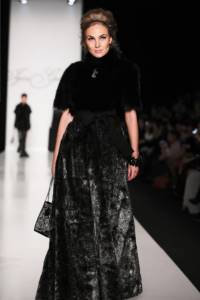
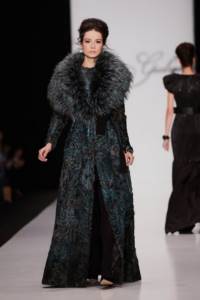
Timeless classics and enchanting femininity emanate from the works of Ulyana Sergeenko, the first lady of Russian fashion, known throughout the world for her luxurious outfits, fluffy skirts, and floor-length dresses.
Do you remember this?
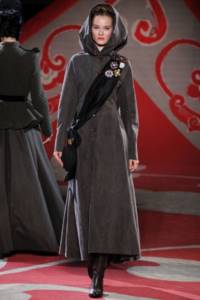
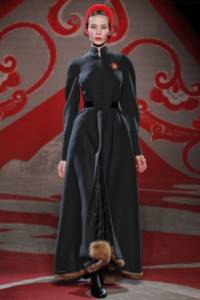
Ulyana herself dresses in the favorite style of a “modern Turgenev girl,” emphasizing in every possible way her femininity and belonging to the Russian nation.
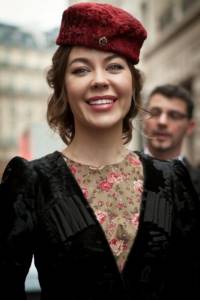
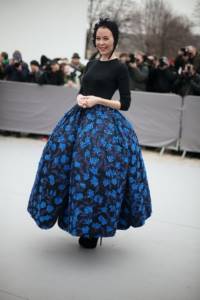
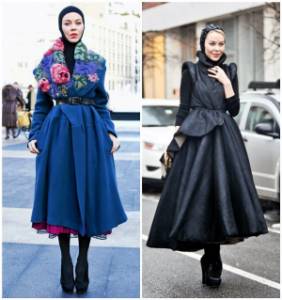
I would also like to add a few words about the clothing brand created by Anastasia Romantsova – “A la Russe”.
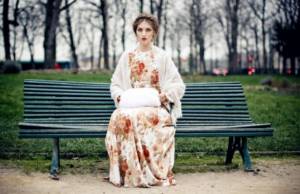
Collection A La Russe by designer Anastasia Romantsova. The works of Olga Vilshenko are very consonant with these palace-fairy-tale moods, where floral patterns, rich embroidery, gold brocade and the strict contrast of white and black create the atmosphere of a bygone era, the times of noble nests, magnificent balls and mysterious strangers, enchanting with their beauty.
I also cannot help but remember the famous kokoshniks of Konstantin Gaidai. Konstantin pleases us with his collections, which take into account all the modern fashion trends of the time.
The collection was inspired by Russian folk costume and traditional headdresses. During his preparation, Konstantin Gaidai studied the religious and cultural traditions of different regions of Russia. This is how 15 images were born, referring to the period at the turn of the 19th-20th centuries, when the Russian style came into fashion - this can be traced and seen in the works of Vasnetsov, Vrubel, and Diaghilev’s “Russian Seasons”. One of the main sources of inspiration for the designer once again became Russian folk tales, without which the history of Russian headdresses would never have sparkled with such bright colors. Goldfish, Firebird, Alkonost
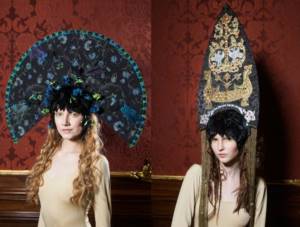
To decorate kokoshniks, Gaidai used elements borrowed from ancient Russian stone architecture, icon frames, gold-embroidered fabrics and famous Russian folk crafts.
And let’s move smoothly to Alena Akhmadullina.
One of the pioneers in Russia in the “a la Russe” style was Alena Akhmadullina, a fashion designer with the appearance of a model and masculine performance.
Even those who purse their lips contemptuously at the mention of Russian fashion go to Alena Akhmadullina’s shows. Whatever you say, her things have their own charisma - they are recognizable and, in the end, beautiful. Akhmadullina diligently follows the chosen theme from season to season. This theme is Russian motifs, presented through rich decoration, sometimes unobtrusively, sometimes “head-on” - for example, this time girls in soft kokoshniks made of fur and velvet walked along the catwalk. But, one way or another, Alena’s Russian theme never looks vulgar.
Russian fairy tales occupy a lot of space in Akhmadullina’s work. For her, it is a storehouse of ideas and a source of inspiration. She knows how to masterfully work with text on fabric and the texture of materials. It is firmly associated with “Russian fashion”.
Alena Akhmadullina FW 2017/18
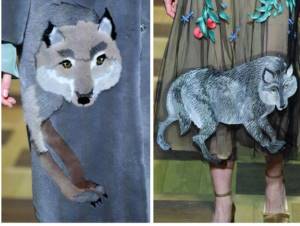
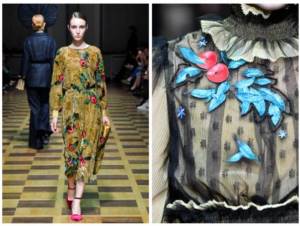
In principle, we can talk about this topic endlessly.
But what comes to your mind first when they say Russian fashion?
Season for shooting
You can enjoy any season and celebrate the best in it. We welcome guests all year round, because the good thing about Russia is that it has hot summers, colorful autumns, elegant winters and gentle springs.
In summer, it is best to take pictures against the backdrop of collected ears of corn, with armfuls of flowers, or on the shore of a pond; photo sessions on hay are also good to do in summer. Summer light is filled with warmth and harmoniously combines with any colors of the suit. You will hardly need any props, just a costume and a summer mood; nature will help with the rest.
Autumn style: harvest, painted trees, wooden walls of warm houses. All this adds some kind of magic, making the faces of the models younger against the backdrop of fading natural beauty;
In winter we get solemn photos, remember only the festive festivities with sleighs and samovars! After the walk, warm up by the warm stove and have a romantic photo shoot in a traditional hut.
Spring streams, watercolor skies and transparent trees - there is a lot of creativity in romantic scenes for photographers. The spring air is saturated with tenderness and awe; it’s time to shoot a Love Story or open the wedding season.
Photo portraits shrouded in the mysterious myths of the ancient Slavs
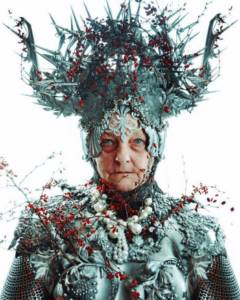
Such splendor of Slavic culture did not leave one Polish photographer Marcin Nagrab indifferent. He decided to show the world that the association with the Slavs is not only vodka, fur hats or the Orthodox Church, but also the rich and extraordinary culture of pagan times.
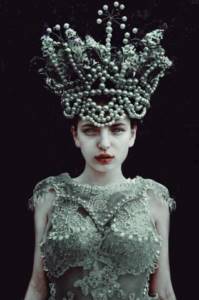
Ancient rituals, mythological deities and their worship are mysterious and enigmatic. Every photograph taken by a Polish photographer shows all this. To take such photos, it would not have been possible without the help of costume designer Agnieszka Osipa. A little imagination and the influence of the spirit of antiquity did the trick. And now everyone can look at these masterpieces and travel a little through time.
Interesting fact: all of Kievan Rus spoke only one language
How to create a fashionable image?
Modern clothing in Russian folk style is a layering of motifs from traditional patterns and ornaments onto current items of clothing.
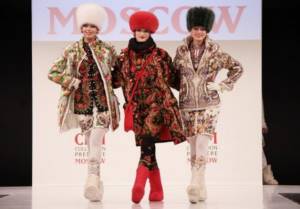
When creating a new look, it is not at all necessary to use only stylistic elements. It is enough to diversify your everyday look with one or two characteristic items. For example, decorate a long summer sundress with a patterned braid and wear shoes with a floral print. You can also complement the ensemble with several strands of pearl beads and choose a handbag to match the main color of the dress.
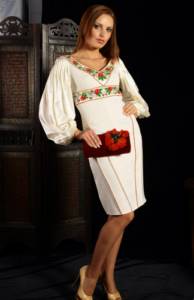
When building your next fashionable look, do not forget that the main principle of Russian style is femininity and chastity. Therefore, it is better to avoid trousers, open and tight-fitting clothes. The beauty of a woman should be presented with dignity and modesty.
Bride's image
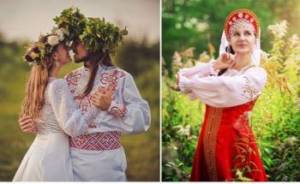
The bride should become the brightest and most attractive image at the Slavic holiday. When choosing an outfit and all accessories, the location (clearing or enclosed space) and time of year will be decisive.
Harsh winters add natural fur, thicker fabrics and massive decorations to the trim of clothing and shoes against this background. The warm season prefers light, loose-fitting materials, sundresses, shoes, and flowing hairstyles.
Wedding Dress
In summer, a dress made of linen fabrics is perfect for a celebration in the Slavic style. It combines naturalness, originality, tenderness and romanticism, as in the photo.
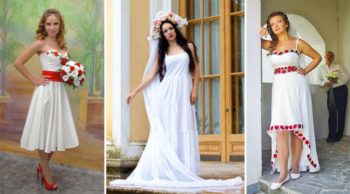
In an ancient wedding dress, the predominant color, the background for decoration, was always red.
Modern stylists, in order to respect this national Russian feature, are developing the concept of a bride's dress with the inclusion of bright details on pure white fabric. Ideally (according to folk tradition), the bride herself prepares her dress for such an important event.
The presence of red color of any shade is required: scarlet, crimson, burgundy.
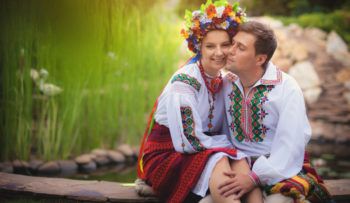
The characteristic details of wedding models of the Slavic style are:
- embroidery with ornaments (flowers) on the bodice;
- puff sleeves;
- wide decorated belt;
- full skirt with a train.
A white sundress is decorated with large red embroidery or, conversely, crimson fabric is used as a base, and the ornament is made white or blue.
Hairstyle
You will have to choose a hairstyle depending on the headdress.
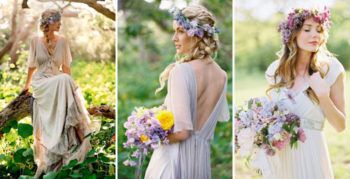
The classic version of the kokoshnik involves a smooth styling, which can be enlivened with pendants made of shiny stones and large earrings. Large curly curls make a good ensemble for a wreath or ribbon.
The stylist's work of hair and woven flowers looks impressive. If the head is mostly open under a veil, wreath or ribbon, then the bride at a wedding in the Slavic style simply needs long hair no matter how it is styled.
The presence or absence of makeup must correspond to the chosen image.
Bouquet
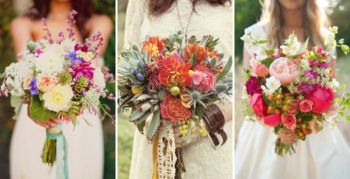
Festive colors include combinations of white, red and blue tones. For this purpose, buttercups, chamomile, poppy, cornflowers, and mallow are collected.
The bouquet includes ears of wheat, viburnum branches, and bunches of heavenly apples.
Accessories
A harmonious image of a bride in the Slavic style is created not only by a dress - it is important to choose the right accessories for it.
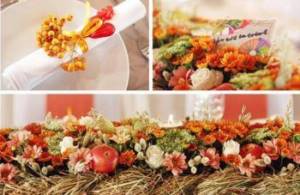
First of all, select a headdress from the following list:
- kokoshnik;
- veil embroidered with bright flowers;
- wreath of wild flowers;
- wide ribbon;
- white fur hat.
At a winter wedding, other accessories will be required to complement the fur headdress: a fur coat, a boa, a muff.
Russian style in women's clothing - beauty and practicality
The harsh climate required people to wear a lot of different things.
- An undershirt is a mandatory element of a suit for women and men. Linen products were sewn freely, not restricting movement. The shirt was supposed to be tied with a belt.
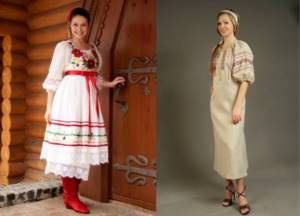
- Poneva is a gathered underskirt that fits tightly around the waist. Created additional volume and insulation.
- A sundress or dress is the main outerwear for women. The loose cut line, expanding from the chest down, hid the outlines of the silhouette. Clothes were made from cotton, linen or wool.
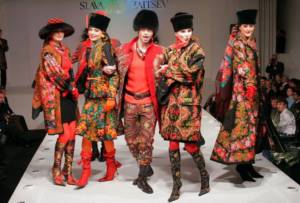
On top they put on soul warmers, sweaters, and shawls over their shoulders. Multilayer clothing provided comfort and kept the body well warm.
In rainy weather, they chose epancha - a sleeveless cloth cloak. Fur coats worn by representatives of all segments of the population reliably protected from frost. Ordinary people sewed clothes from sheepskin or hare. The nobility wore sable, silver fox, and marten. The fur coats were long and heavy with a wide round collar. They were worn with the fur inside, covered with thick cloth, velvet or brocade on top.
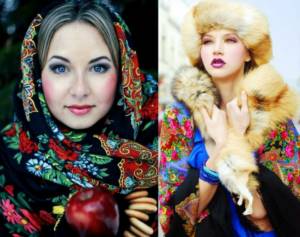
Hands were covered from the cold with knitted or fur mittens. At home, women wore kokoshniks on their heads. When going outside, they tied scarves on top or put on round fur hats.
